
Fact Sheets And Publications
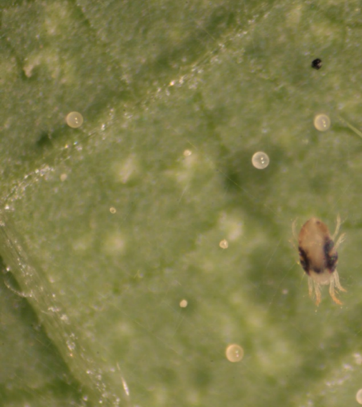
Two Spotted Spider Mite
Scientific name: Tetranychus urticae Koch
Order: Acari
Family: Tetranychidae
Description
The twospotted spider mite (TSSM) is a plant-feeding mite that is an extremely widespread pest affecting nearly all crop plants (over 1000 plant species). TSSM is very small in size and requires magnification to see clearly. TSSM have two body segments called the cephalothorax and the abdomen, four pairs of legs, a pair of red ocelli (eyes), and no antennae. They have piercing-sucking mouthparts, known as chelicerae, which they use to feed on plants. Adult TSSM also have two large dark colored spots on the sides of their bodies hence their common name.
Life History and Phenology
Female spider mites begin laying eggs in the early spring. The eggs are spherical and slightly opaque, normally in a loose cluster with other eggs, and close to or on webbing. Eggs hatch into six-legged larvae. Larvae molt to an eight-legged protonymph, followed by a deutonymph prior to molting to the adult stage. The large feeding spots become pronounced in the deutonymph stage. The entire life cycle can take between seven days and three weeks to complete, dependent on temperature. . Under ideal conditions (hot, dry weather, lack of natural enemies, and well-fertilized plants), mite populations can increase 10-fold per week.
TSSM enter diapause to overwinter, usually in ground cover, under loose soil or even tree bark. In warmer locations, TSSM may not diapause and instead infest a different host plant until the spring. Diapausing spider mites slowly change to an orange color and the dark feeding spots on the side of the body fade. TSSM diapause as mated females and once their overwintering cycle is over, the mites crawl towards established plants to start feeding and reproduce. Once a plant is too damaged for spider mites to feed on, they disperse by crawling laterally, crawling to the apex of a plant to catch wind currents, or by simply hitchhiking on larger organisms to reach a new feeding site.
Damage
Damage from TSSM occurs when the mite pierces plant cells with its mouthparts and drains their contents. Once drained of its contents, the plant cell appears yellow in color and with many mites feeding at once scattered around the leaf, the yellowing of the leaf is spotty. Feeding can increase under hot and dry conditions because TSSM increase the rate in which they feed to prevent body water loss. Feeding damage from T. urticae can appear in the form of yellowing leaves, decreased plant growth and yield, and depending on the level of infestation, death of the plant1.
Spider mites can also cover plants in webbing which the mites use to travel around the plants and to protect eggs from predators and from drying out. While this webbing will not cause physical damage, it may not be aesthetically pleasing or acceptable for ornamental plants. The webbing also interferes with pesticide efficacy, shielding the mites and the leaf surface from spray droplets. In some highly specialized hemp markets, the webbing could detract from hemp bud quality.
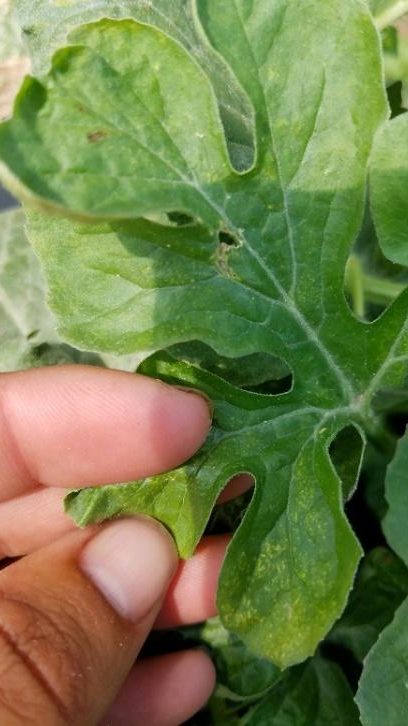
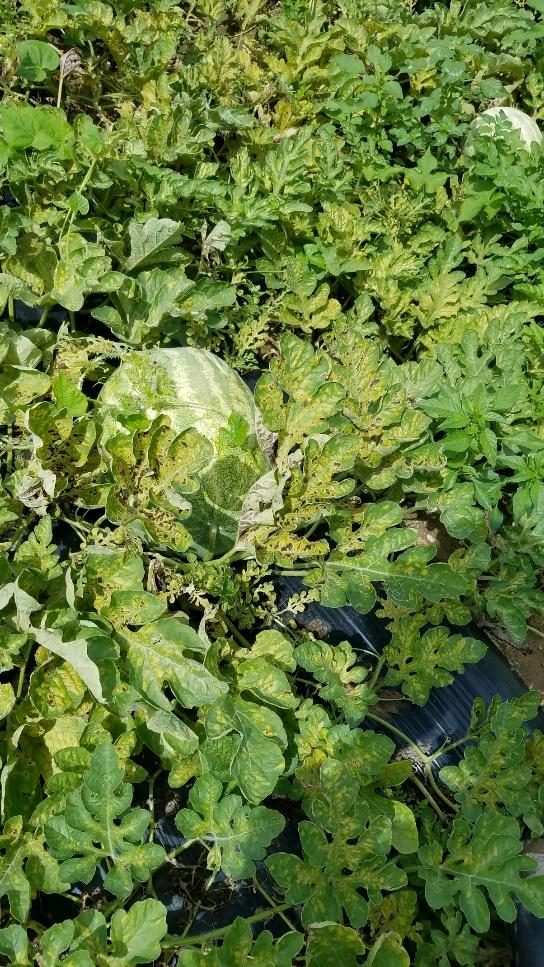
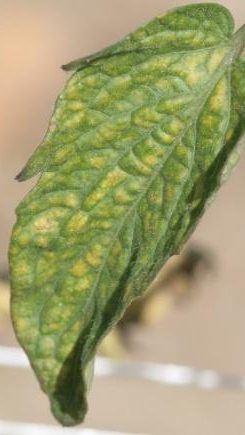
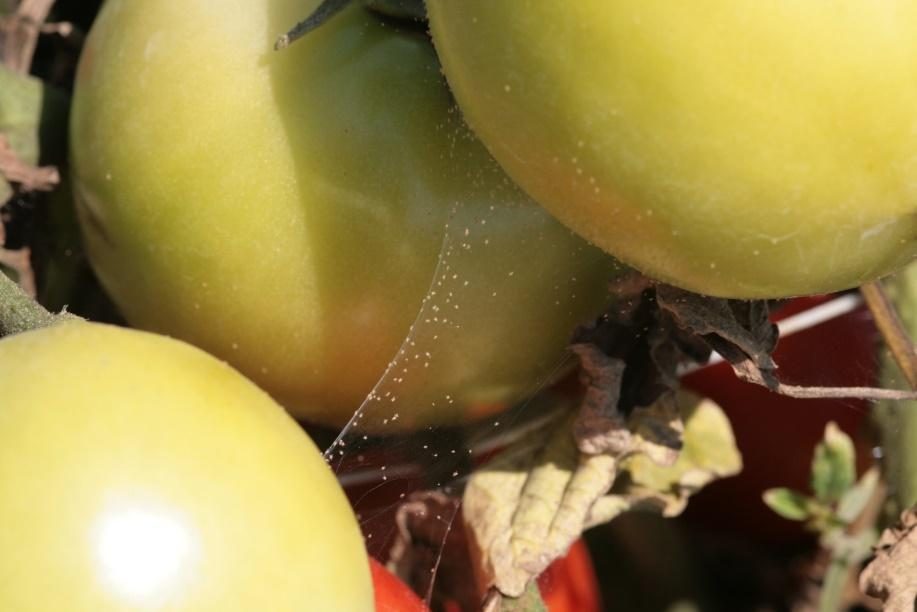
Factors that contribute to Spider Mite Outbreaks in Vegetables
Spider mites tend to be more severe and treatments required more often in vegetables for several reasons. On Delmarva, we grow many vegetables on black plastic to warm the soil early. Warmer conditions promote spider mite development. Our sandy soils hold less water causing weeds around field edges to frequently become water stressed. This stimulates mites to move to adjacent crops. Vegetable production also tends to use neonicotinoid and pyrethroid insecticides much more frequently than field crop production. Neonicotinoids can stimulate mite reproduction via a phenomenon known as hormoligosis2. Hormoligosis occurs when a mild stressor (such as a pesticide application) causes an organism to increase reproduction. Both pyrethroids and neonicotinoids kill beneficial arthropods that would otherwise eat spider mites. Frequent fungicides are required to maintain vigor and quality in vegetables, but they also can kill beneficial fungi that attack mites, such as Neozygites. Finally, high fertilizer use in vegetables creates plants that are more nutritious for the mites, increasing population growth.
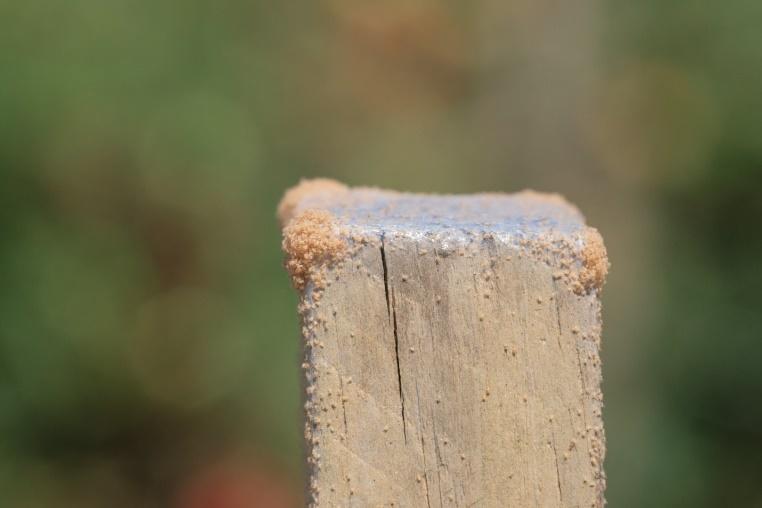
Prevention and Cultural Management
Proper weed management is extremely important in preventing spider mite problems. Weed growth in greenhouses, particularly during warm winters, give spider mites alternate hosts on which they can continue to reproduce. In spring, these mites will colonize transplants. Greenhouse weed control should be initiated in the fall and continue until winter annuals stop germinating. In October, spider mites begin to enter diapause and are much more difficult to kill or disrupt as they are in a state of low activity and decreased feeding. In summer months, spider mites developing in weeds around field edges may be forced into the crop if weeds are mown, especially during periods of hot, dry weather. Some weeds, such as pokeweed, seem to harbor more spider mites than others earlier in the season.
Another means of preventing spider mite problems within a farm is to prioritize work in fields with low spider mite activity before moving to heavily infested fields. When a heavily infested field begins to decline due to spider mites, the mites will start congregating on high points to disperse. Workers or machinery that brushes up against these aggregations can carry large numbers of mites to other fields. Once a field is infested, limiting abiotic stress as much as possible will help the plants tolerate higher mite presence.
Sampling and Decision Making
Sampling for TSSM usually requires looking at individual leaves under magnification such as a 10x loupe or a 3.5x visor lens. Crops vary in how much they can withstand an infestation, but generally are much more susceptible to mite infestation and injury during their reproductive stages. In general, sample 5 to 10 leaves, upper canopy terminal leaflets (tomato) or mid-tier leaflets (strawberry) from 10 spots in the field. Scouting near the edge of a field can help monitor initial mite movement into the field. It is best to scout a field weekly when dealing with spider mites, especially in hot dry weather when their populations and damage increases rapidly. Recent watermelon field trials demonstrated a tenfold increase in population in a week. Also be sure to scout greenhouses where transplants are grown.
| Crop | Threshold | Notes | ||||
|---|---|---|---|---|---|---|
| Eggplant | 4-8 mites/leaf | Study on related T. marianae in the Mariana Islands(3) | ||||
| Beans | 20 mites/leaflet, early | UD extension recommendations | ||||
| Tomato | 4-8 mites/leaflet on 2nd or 3rd recently expanded terminal leaflet | North Carolina(4) | ||||
| Soybean | 20-30/leaflet and 10% plants with 1/3 or more leaf area damaged; Soybeans in their reproductive stages | UD extension recommendations | ||||
| Summer Squash | Early season 10-15% crown leaf infestation | Mid-Atlantic Commercial Vegetable Production Recommendations | ||||
| Strawberry | 5 mites/leaflet pre-fruit 15 mites/leaflet fruiting |
University of California recommendations | ||||
| Watermelon | 20-30% crowns infested with 1-2 mites/leaf early; 50% terminal leaves later in season | Mid-Atlantic Commercial Vegetable Production Recommendations; UD extension recommendations | ||||
| Field Corn | Dynamic threshold based on % leaves infested and % leaf area damaged | Nebraska extension recommendations |
Natural Enemies
There are numerous predatory mite species in the family Phytoseiidae that prey upon spider mites. In general, predatory mites in general have pear shaped bodies, clear to orange in color, and with long forelegs. They use the forelegs to search for prey. Predatory mite eggs are clear and oval shaped, as opposed to the spherical TSSM egg.
Brief descriptions of two commercially available species are provided below. There are other species that are commercially available for spider mite management. Phytoseiids may be present in fields infested with spider mites, thus, reducing broad spectrum insecticide use and applying selective miticides will preserve predatory mites present.
Phytoseiulus persimilis- specialist predator on TSSM. It is solid orange-red in color. It reproduces rapidly and consumes up to to 5 – 20 prey items per day. Once established, they can quickly bring a spider mite population under control, but once they run out of prey, they will either disperse or starve. Prefers hot, humid weather.
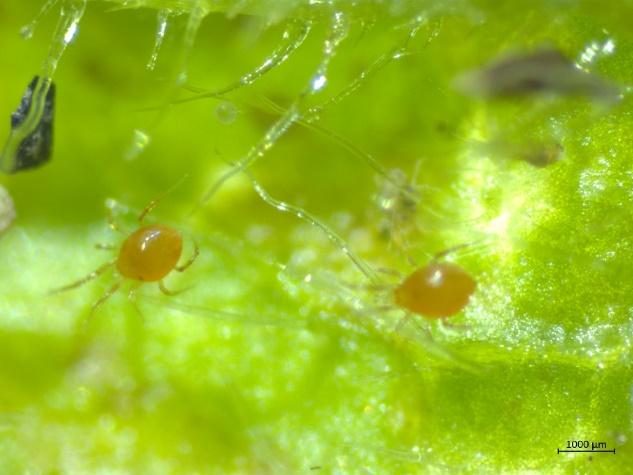
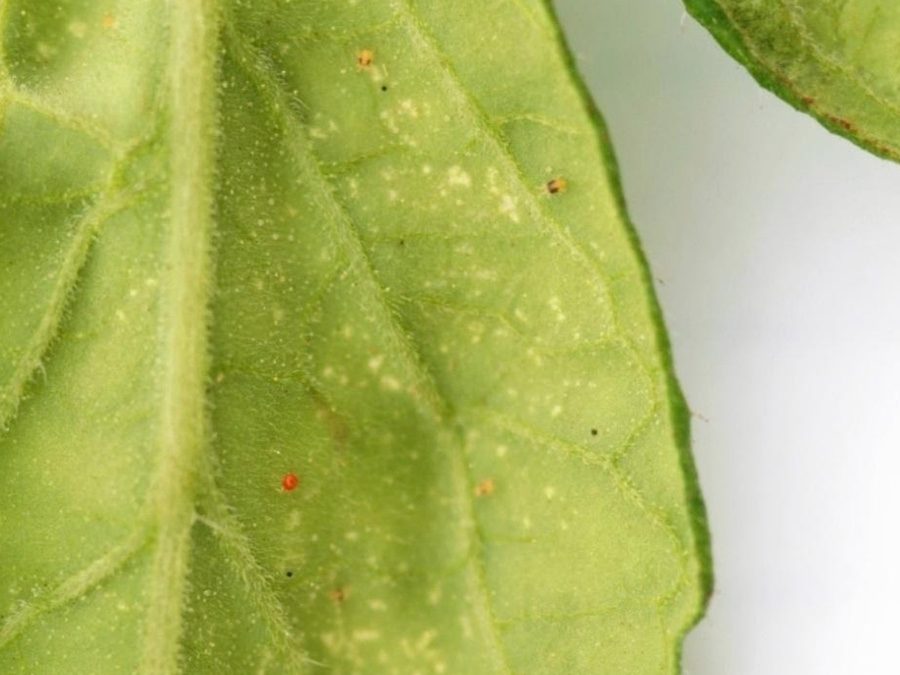
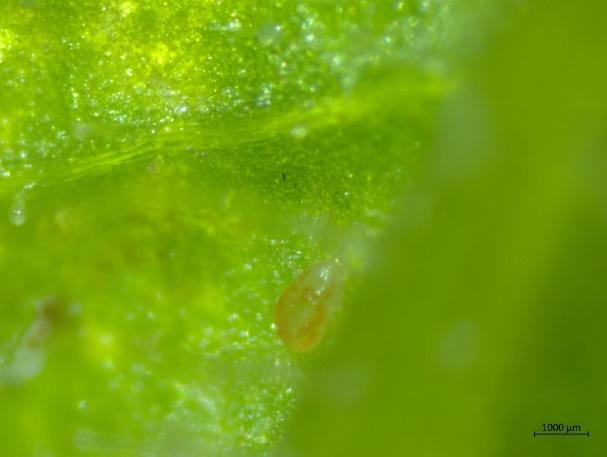
Neoseiulus fallacis - A native Phytoseiid that is a light cream to mottled color. It is not as prey-specific as P. persimilis. It can sustain itself for some time on other mite groups, thrips, bark lice, and whiteflies, as well as some plant pollens5,6. It can be an important natural enemy in more permanent environments such as orchards where several preferred prey items are available during the year. This species has been found in low numbers around the edges of some vegetable fields in Delaware. It does not control spider mite populations as quickly as P. persimilis but persists in the environment longer and is more tolerant of drier conditions.
In our experience, it takes close to three weeks for commercially purchased predators to establish themselves and reproduce to a point where it may be possible to exert control on two spotted spider mites. Ratios between 1:10 and 1:20 predators: prey should be sufficient to cause an imminent spider mite population crash. If purchasing predatory mites, keep shipping costs in mind. Predators should be shipped overnight and deployed as soon as possible upon arrival. If immediate deployment is not possible, they can be stored in a cool dark room, or a ‘warm’ refrigerator for a brief period of time (no more than a day). Predators should be deployed either early in the morning or late in the afternoon to minimize abiotic stress during release and to prevent them from overheating in the bottle as they are being released. Phytoseiulus persimilis is the only predatory mite that can handle the trichomes of tomato, and even then, establishment is much slower than in other crops.
Other non-mite, commercially available predators that are important biological control agents include predatory midges (Feltiella), pirate bugs (Orius), six-spotted thrips, and lady beetles (Stethorus). Predatory midges, pirate bugs, and Stethorus are commonly encountered in spider mite infested weeds and fields. However, their populations usually develop slower. We do not have any experience field releasing these, and they are much more expensive. In addition, they all have wings, allowing them to rapidly disperse out of the target area. As such, they would be of better use in a greenhouse and should be conserved by using IPM-friendly pesticides when they are present.
Neozygites floridana is a species of fungus that can infect spider mites and multiply rapidly to kill a mite and mummify it and then infect more mites7. It is one of the most significant factors in spider mite population declines in field crops, but application of broad-spectrum fungicides can reduce its effectiveness8,9.
Chemical Control
TSSM can be difficult to control with chemicals. Their rapid reproduction and development increases the chances of resistance development within a single season. Spider mites can also form highly inbred colonies because an unmated female can lay unfertilized (male) eggs. Once offspring males mature, they can inbreed with the female and she can then lay fertilized (female) eggs. This allows resistance to spread rapidly10. The results of resistance include continued crop damage and the need to make a reapplication, both of which reduces revenue from the field. TSSM are resistant to most pyrethroids and in some cases certain chemicals can increase oviposition rates11. Rotating miticides among mode of action group numbers will help prevent resistance. It is best to keep in mind the life cycle of the spider mite that a chemical targets because some chemicals affect the eggs while others focus on mobile growth stages.
OMRI approved miticides include horticultural oils, sulfur, insecticidal soaps, some biopesticides, and products containing plant essential oils. Oil and soap products work as contact agents that smother the mites. As such, they require both high use rates and high water volumes. Horticultural oils also run the risk of phytotoxicity if applied in warm to hot weather conditions. These products tend to have very little residual activity.
The table below lists miticides labeled for various crops. There are generic formulations of some chemicals that may differ in use patterns, rates, and crops they may be applied to. Different Modes of Action (MOAs) target different parts of mite physiology. As always, consult labels for usage, application directions, and restrictions. Also pay attention to maximum use rates per acre; many miticides can also only be applied once or twice per season.
Green is compatible with predatory mites and beneficial insects unless otherwise noted; orange represents moderate toxicity, and red represents high toxicity. Sources include University of California IPM webpage, www.biobestgroup.com, and Bergeron and Schmidt-Jeffris 202013
Product (Active Ingredient) |
Modes of Action (MOA) |
Life stage active |
Crop Group (rate/acre) |
Notes |
|---|---|---|---|---|
Agri-Mek (Abamectin) |
6 |
Mobiles (translaminar) |
Eggplant (1.75-3.5 fl oz) Pepper (1.75-3.5 fl oz) Melons (1.75-3.5 fl oz) Strawberry (1.75-3.5 fl oz) Tomato (1.75-3.5 fl oz) Bean (1.75-3.5 fl oz) Sweet Corn (1.75-3.5 fl oz) Soybean** (1.75-3.5 fl oz) |
NIS welting or spreading adjuvant must be added to avoid illegal residues Toxic to bees |
Gladiator (Zeta-cypermethrin + avermectin B1) |
3 + 6 |
Mobiles (transluminar) |
Eggplant (19 fl oz) Pepper (19 fl oz) Melons (19 fl oz) Beans (19 fl oz) Tomato (19 fl oz) |
Binder or stickers antagonistic Toxic to bees |
Acramite 50 WS (Bifenazate) |
20D |
Eggs and Mobiles (contact) |
Beans (1.0-1.75 lbs) Eggplant (0.75-1.0 lbs) Pepper (0.75-1.0 lbs) Melons (0.75-1.0 lbs) Stawberry (0.75-1.0 lbs) Tomato (0.75-1.0 lbs) |
Boron and chlorine inhibit water soluble bag dissolution Apply when bees not foraging |
Kanemite (Acequinocyl) |
20B |
Eggs and mobiles (translaminar) |
Beans (31 fl oz) Eggplant (31 fl oz) Pepper (31 fl oz) Melons (31 fl oz) Strawberry (21-31 fl oz) Tomato (31 fl oz) Edamame (31 fl oz) |
A water conditioning agent may correct hard water conditions; Do not combine with Fosetyl Apply when bees not foraging |
Oberon 2SC (Spiromesifen) |
23 |
Juveniles (contact) |
Eggplant (7.0-8.5 fl oz) Pepper (7.0-8.5 fl oz) Melons (7.0-8.5 fl oz) Strawberry (12.0-16.0 fl oz) Corn (Sweet, Field) (5.7-16 fl oz) Tomato (7.0-8.5 fl oz) |
No bee cautions on label Not toxic to beneficial insects except Feltiella |
Portal (Fenpyroximate) |
21A |
Mobiles (contact) |
Snap beans (32 fl oz) Eggplant (32 fl oz) Pepper (32 fl oz) Melons (32 fl oz) Strawberry (32 fl oz) Tomato (32 fl oz) |
No bee cautions on label Not toxic to beneficial insects |
Zeal SC (Etoxazole) |
10B |
Ovicidal, juveniles (translaminar) |
Melons (4-6 fl oz) Soybean (2-6 fl oz) Corn, Field and Sweet (2-6 fl oz) |
Boron may interfere with efficiency Apply when bees not foraging |
Zeal (water soluble packet) Eggplant (2-3 oz) Pepper (2-3 oz) Strawberry (2-3 oz) |
||||
Onager EC (Hexythiazox) |
10A |
Ovicidal, juvenile |
Field Corn (12-24 fl oz) Eggplant (12-14 fl oz) Pepper (12-24 fl oz) Strawberry [Onager Optek only] (12-32 fl oz) |
Apply when bees not foraging |
Vendex 50WP* (Fenbutatin-oxide) |
12B |
mobiles |
Eggplant (2-3 lbs) Strawberry (1.5-2.0 lbs) |
Boron may interfere with pack solubility No bee cautions on label |
Nexter SC (Pyridaben) |
21A |
Eggs and mobiles |
Strawberry (7.5-17 fl oz) |
|
Magister SC (Fenazaquin) |
21A |
Eggs and mobiles |
Melons (24-36 fl oz) Tomato (24-36 fl oz) Eggplant (24-36 fl oz) Pepper (24-36 fl oz) Beans (32-36 fl oz) Stawberry (32-36 fl oz)
|
Highly toxic to bees |
Nealta SC (Cyflumetofen) |
25 |
Eggs and mobiles |
Strawberry (13.7 fl oz) Tomato (13.7 fl oz) |
No bee cautions on label |
KEY: *Not registed in MD or PA; **Only Agri-Mek SC is labeled for soybeans, not generics |
||||
Always rotate among modes of action between sprays, not within a mode of action number (ie. 10A to a 10B is not a rotation, but a 10B to a 21A is). Also, some of these products will stop mite feeding quickly, but the mite will take a few days to die. Dimethoate is also sometimes recommended as a miticide on various crops, plants should not be drought stressed when applied.
For soybean, three materials have been previously recommended: bifenthrin (a pyrethroid), Lorsban, and Dimethoate (both organophosphates). While they can knock spider mites back, mites will quickly recover from the application. If using these materials, be prepared to treat twice. Dimethoate works best when there is sufficient soil moisture for the plants to actively transpire. This enables the chemical to move into the plant tissue and significantly increases its residual activity. Otherwise, when applied to drought stressed plants the material rapidly photodegrades on the leaf surface. Bifenthrin and other pyrethroids (MOA group 3) are inconsistent; pyrethroid resistance is common in some spider mite populations. These materials will also remove beneficial predatory insects.
As always, read the label thoroughly for further guidance, especially for number of applications, reapplication interval, restrictions on consecutive application, and adjuvant requirements. Good coverage is key for miticide efficacy, even on those that are translaminar.
Acknowledgements
This fact sheet was graciously edited and improved by Dr. Rebecca Schmidt-Jeffris (USDA-ARS). Delaware research and observations that were instrumental in supporting some of the statements in this fact sheet was supported by the Delaware Department of Agriculture Specialty Crop Block Grant SCBGP-FB-18-03.
Selected References
1 Golec, J. R., Hoge, B., and Walgenbach, J. F. 2020. Effect of biopesticides on different Tetranychus urticae Koch (Acari: Tetranychidae) life stages. Crop Protection 128: 105015
2 Beers, E. H., J. F. Brunner, J. E. Dunley, M. Doerr, and K. Granger. 2005. Role of neonicotinyl insecticides in Washington apple integrated pest management. Part II. Nontarget effects on integrated mite control. Journal of Insect Science 5:16.
3 Reddy, G.V.P., R. Kikuchi, and J. R. Bautista. 2012. Threshold-based spraying decision programmes for the red spider mite Tetranychus marianae on eggplant. Journal of Applied Entomology 137: 429-436.
4 Meck, E. D., G. G. Kennedy, J. F. Walgenbach. 2013. Effect of Tetranychus urticae (Acari: Tetranychidae) on yield, quality, and economics of tomato production. Crop Protection. 52: 84-90
5 McMurty, J. A. and Croft, B. A. 1997. Life-styles of phytoseiid mites and their role in biological control. Annual Review of Entomology. 42: 291-321
6 Pratt, P. D., P. Schausberger, and B. A. Croft. 1999. Prey-food types of Neoseiulus fallacis (Acari: Phytoseiidae) and literature versus experimentally derived prey-food estimates for five phytoseiid species. Experimental and Applied Acarology 23: 551-565.
7 Van Der Geest, L. P. S., Elliot, S. L., Breeuwer, J. A. J., and Beerling, E. A. M. 2000. Diseases of mites. Experimental and Applied Acarology 24: 497-560
8 Boykin, L.S., W. V. Campbell, and M. K. Beute. 1984. Effect of pesticides on Neozygites floridana (Entomophthorales: Entomophthoraceae) and arthropod predators attacking the Twospotted spider mite (Acari: Tetranychidae) in North Carolina peanut fields. Journal of Economic Entomology 77: 969-975.
9 Smitley, D. R., G. G. Kennedy, and W. M. Brooks. 1986. Role of the entomogenous fungus, Neozygites floridana, in population declines of the twospotted spider mite, Tetranychus urticae, on field corn. Entomologia Experimentalis et Applicata 41: 255-264.
10 Bi, J., Niu, Z., Yu, L., and Toscano, N. C. 2016. Resistance status of the carmine spider mite, Tetranychus cinnabarinus and the twospotted spider mite, Tetranychus urticae to selected acaricides on strawberries. Insect Science 23: 88-93
11 Castagnoli, M., Liguori, M., Simoni, S., and Duso, C. 2005. Toxicity of some insecticides to Tetranychus urticae, Neoseiulus californicus and Tydeus californicus. Biocontrol 50: 611-622
12 Bergeron, P. E. and R. A. Schmidt-Jeffris. 2020. Not all predators are equal: miticide non-target effects and differential selectivity. Pest Management Science 76: 2170-2179.
UD Cooperative Extension
This institution is an equal opportunity provider.
In accordance with Federal law and U.S. Department of Agriculture policy, Cooperative Extension is prohibited from discriminating on the basis of race, color, national origin, sex, age, or disability.
